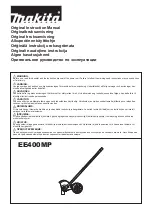
E-Gel
™
Power Snap Electrophoresis System User Guide
39
Electrical requirements
Warning
: For safety, the power outlet used for powering the instrument must be accessible at all times. In case of
emergency, you must be able to immediately disconnect the main power supply to the instrument. Allow adequate
space between the wall and the equipment so the power cord can be disconnected in case of emergency.
•
Electric receptacle with grounding capability
•
Maximum power dissipation: ~90 W
•
Mains AC line voltage tolerances must be up to ±10 percent of nominal voltage
Rated Voltage
(Input)
Rated Current
(Input)
Rated Frequency
(Input)
Rated Power
(Output)
AC/DC Power Supply
100–240 VAC
±10%
1.3 A
50/60 Hz
90 W
E-Gel
™
Power Snap
Electrophoresis Device
48 VDC ±2.5%
1.87 A
N/A
N/A
E-Gel
™
Power Snap Camera
Does not function as a standalone device. Powered from E-Gel
™
Power Snap
Electrophoresis Device.
Environmental requirements
Condition
Acceptable Range
Installation site
Indoor use only
Electromagnetic
interference
Do not use this device in close proximity to sources of strong electromagnetic radiation
(for example, unshielded intentional RF sources). Strong electromagnetic radiation may
interfere with the proper operation of the device.
Altitude
Between sea level and 2000 m (6500 ft.) above sea level
Operating conditions
•
Humidity: 15–80% relative humidity (noncondensing)
•
Temperature: 15 to 30°C (59 to 86°F)
Note: For optimal performance, avoid rapid or extreme fluctuations in room
temperature.
Storage and transport
conditions
•
Humidity: 20–80% relative humidity (noncondensing)
•
Temperature: –30 to 60°C (–22 to 140°F)
Thermal output
During operation, the net thermal output, based on the actual current draw of the
instrument, is expected to be approximately 72 W (245.67 Btu/h).
Vibration
Ensure that the instrument is not adjacent to strong vibration sources, such as a
centrifuge, pump, or compressor. Excessive vibration will affect instrument
performance.
Pollution degree
The instrument has a Pollution Degree rating of II. The instrument may only be installed
in an environment that has nonconductive pollutants such as dust particles or wood
chips. Typical environments with a Pollution Degree II rating are laboratories and sales
and commercial areas. The noise output of the instrument is ≤ 45 dB(A) when running.
Other conditions
Ensure the instrument is located away from any vents that could expel particulate
material onto the instrument components.
Avoid placing the instrument adjacent to heaters, cooling ducts, or in direct sunlight.
















































